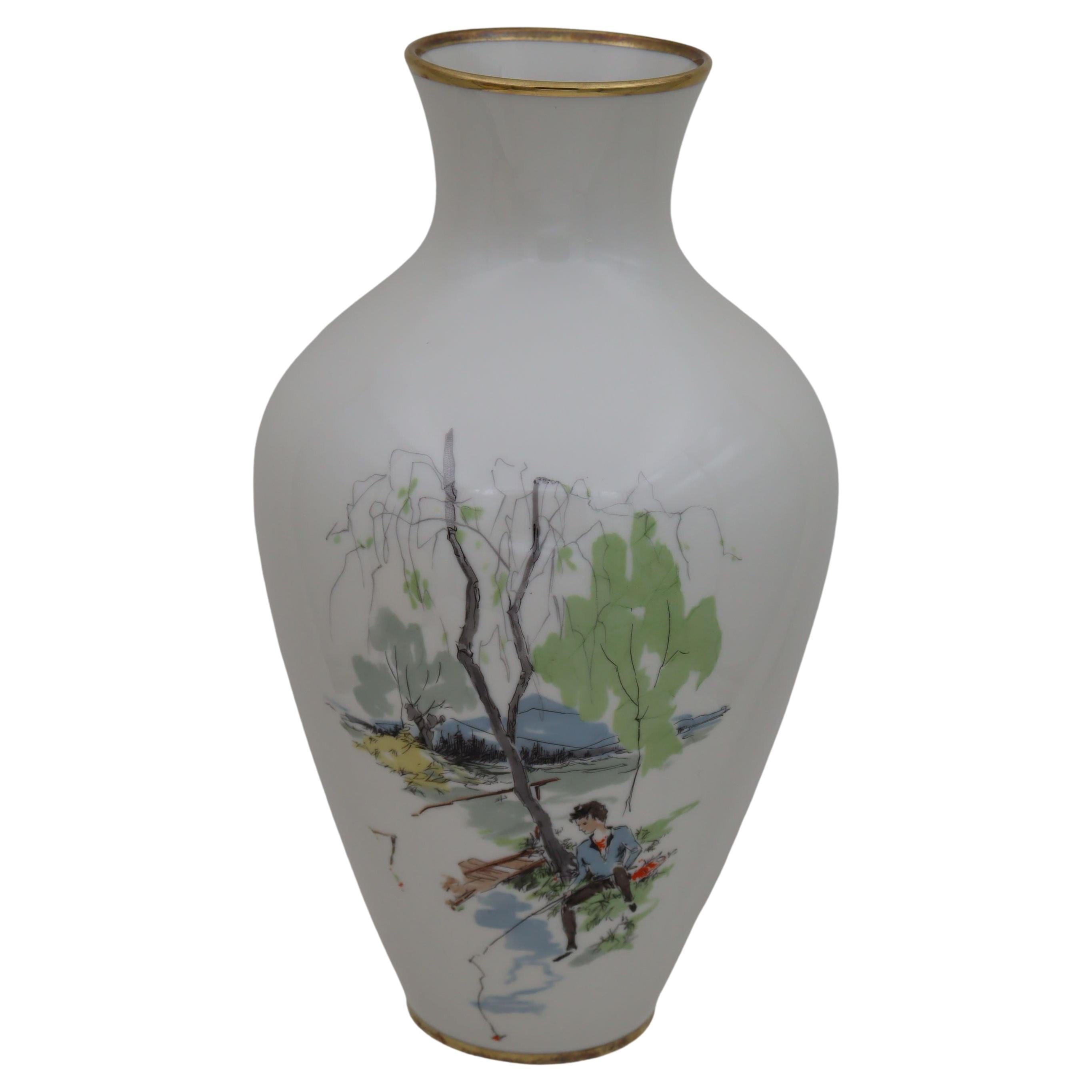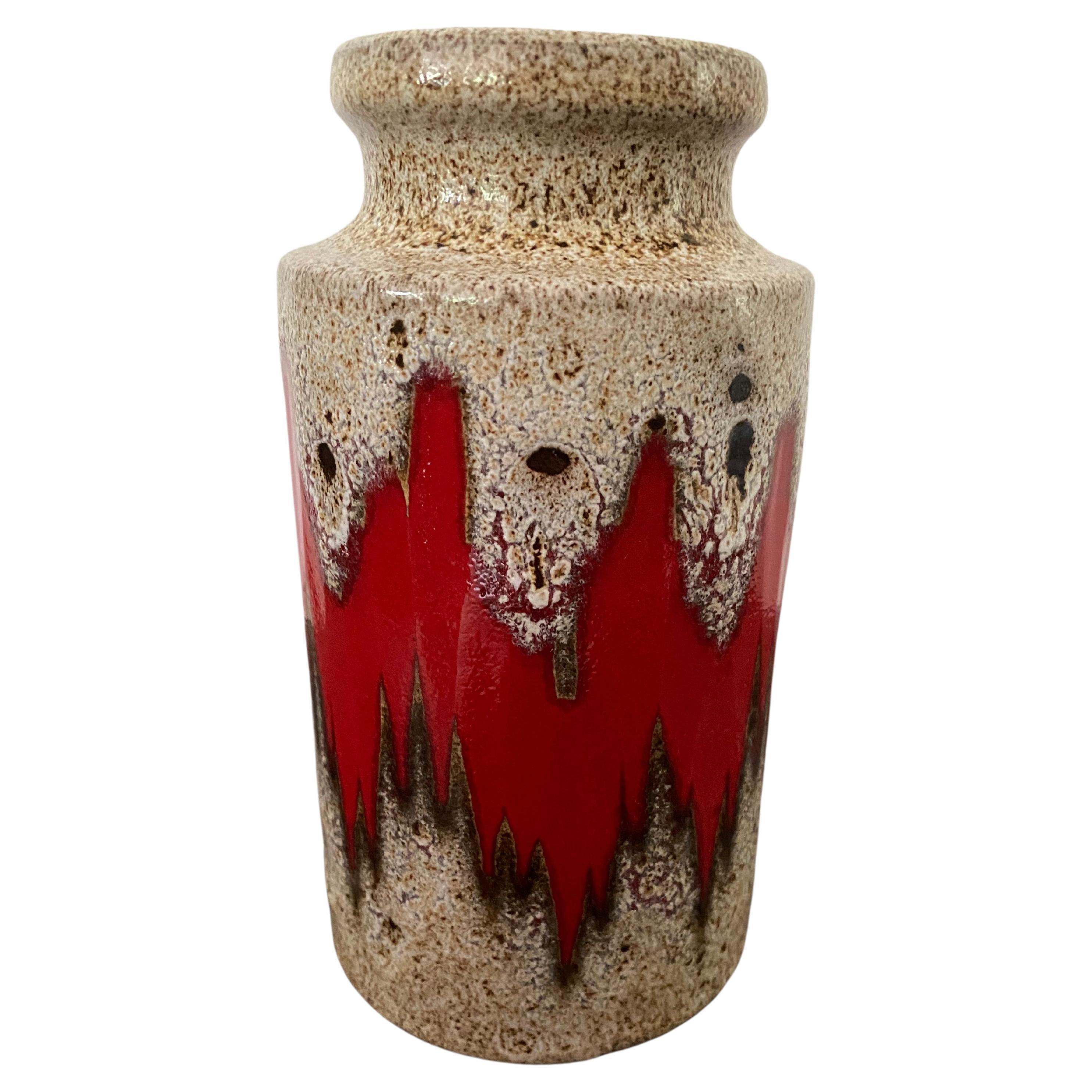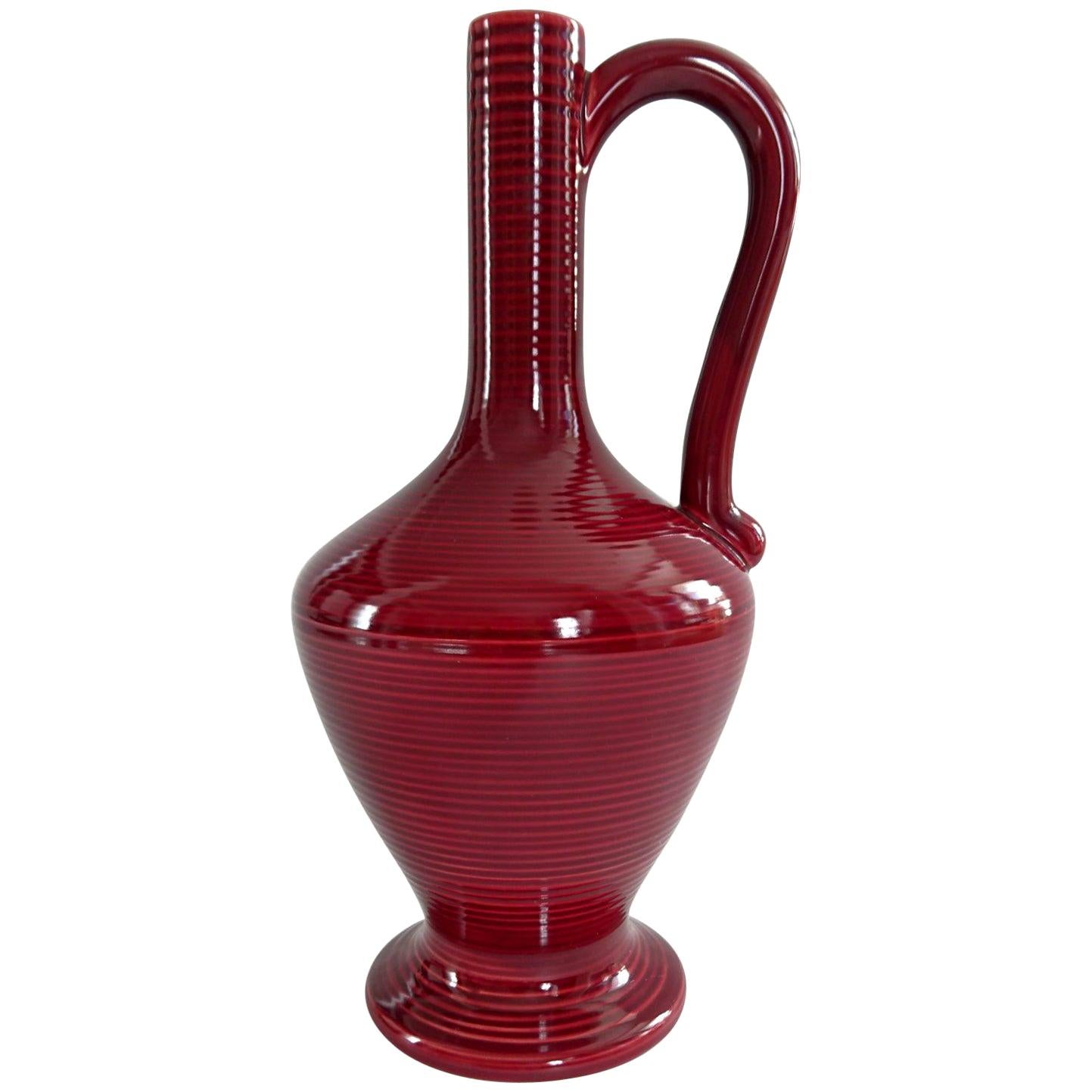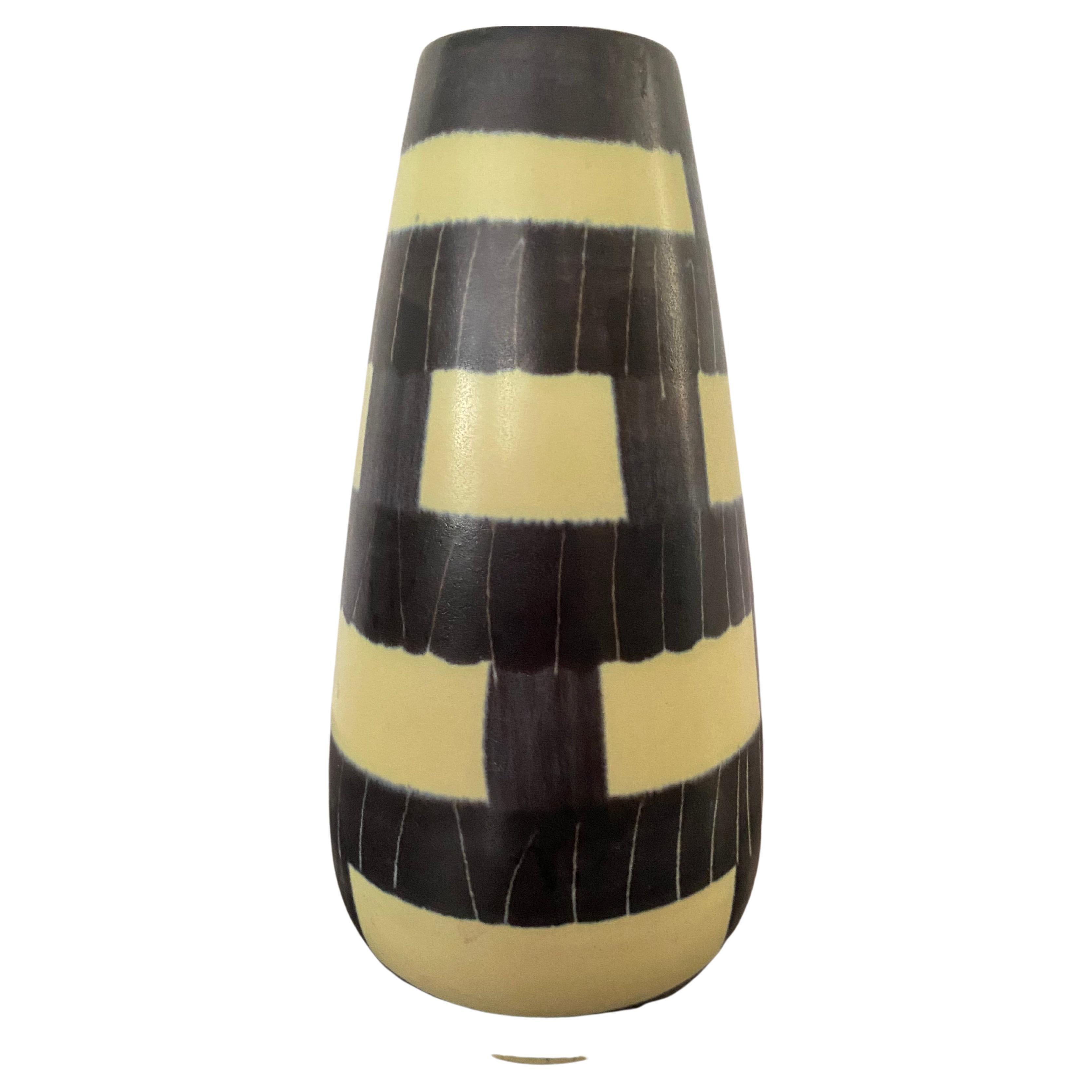Items Similar to Bohemian "Flux" vase by kuk Fachschule fur Keramik und Verwandte Kunst
Want more images or videos?
Request additional images or videos from the seller
1 of 10
Bohemian "Flux" vase by kuk Fachschule fur Keramik und Verwandte Kunst
About the Item
BOHEMIAN FLUX: A VASE, kuk Fachschule für Keramik und Verwandte Kunstgewerbe, Turn-Teplitz, c. 1905; the ceramic vase with a dark underglaze ground has a matte orange peel overglaze in ochre, apricot, lapis and celadon; the shape of the vase resembles a Japanese Saki bottle with the addition of four long and slender handles at the top third; incised before firing on the base in script lettering,“P.W.”, stamped before firing with the Fachschule mark and 73, and marked “G2.” in black ink; the vase measures: 13” high.
Flux- continuous moving, a glazing method, fusion- the artist who produced this remarkable vase has presented a profoundly poetic and technical meditation on this subject. Moving way beyond the pursuit of creating only functional objects, the student ceramists at Fachschule Teplitz had ingrained in them the Europeans’ fascination for Japanese objects “from the floating world” and the design aesthetic known as Japonisme. Truly modern interpretations of Japonisme had begun to evolve into an internalizing of the aesthetic principles and a shift away from imitation of Japanese style applied to a Western format.
This vase is noteworthy in that it illustrates this important Modernist shift in European ceramics. The elements of the saki bottle can be divided into three key components which taken as a whole create a rather feminine line. In keeping with this approach, the Fachschule student presents a slender bare neck, like décolletage, which flares ever slightly and then narrows to a high waist before voluptuously widening down and terminating gracefully to a round base. The ceramist gives special emphasis to pleasing proportions and the complementary relationship to the number 3; the measurement at the widest section of the vase equals the same distance from that point up to where the bottoms of the handles join to the body of the vase as well as the full arms’ length. Instead of inscribing the vase with Japanese calligraphy denoting a saki shop, the student takes a radically modern approach by attaching the vase with four handles. And yet, this act is every bit a form of written identification. The arms are the embodiment of the idea of flux in that they are a substance applied to a surface by the welding together to promote their union. The handles serve a new and surprising function. They are carriers of a concept. Fluidity- flux -can be created when an artist joins disparate elements into a harmonious whole.
Flux is also a substance used to promote the fusion of minerals and metals and a term describing ceramic glazing. The presence of silica in glazes creates a glassy finish when fired at high temperatures. Matte glazes result from the presence of crystals under the surface and the balance between silica, flux and alumina in the glaze materials. By deliberately under-firing this vase and playing with a combination of additives forming the flux glaze, the end result appears matte and textured. The orange peel quality and alluring color palette are transformative. The effect evokes a waterfall or another continuous moving flow of water like a stream - in flux.
So not only does this artist take a Meiji Period saki bottle and the aesthetic tenets of Japonisme as the formal and theoretical points of departure, the artist infuses the work with the symbolism of skill itself where artistic mastery as the embodiment of flux becomes the subject to ponder. As a fully realized and beautifully rendered piece, the vase attests to the artistic prowess of its creator. No longer a mere student working in the shadows of the teacher and no longer simply imitating or replicating past styles, this emerging artist shows the complete fluid transfer from student to master ceramist. Seen in this light, the vase represents a significant and pivotal achievement in Modern European ceramic ware.
Fachschule für Keramik und Verwandte Kunstgewerbe (the Imperial School for Ceramics and Associated Applied Arts, 1875-1917) was a powerhouse of the ceramics industry. Located in the Turn-Teplitz region of Bohemia near the German border of what is today The Czech Republic, this was Europe’s largest pottery center in the first part of the 20th century. The school played an integral role in the center’s internationally regarded success as it provided the foundation of sourcing and training new talent for noted local manufacturers such as Amphora. It was at the Fachschule that master artists from these local ceramics houses enjoyed teaching and lecturing posts, and in true synergistic spirit, the big ceramics houses in turn supplied the school with raw material such as clay and glazing minerals. Much more than a school, the Fachschule für Keramic in Turn-Teplitz was a hotbed of creative activity which produced masterful works on par with their commercial peers. Fachschule Teplitz’s inclusion at l’Exposition Universelle in Paris in 1900 and at the World’s Fair held in St. Louis in 1904, at the zenith of this region’s ceramic output, illustrates to what high degree it was esteemed among the art world.
- Dimensions:Height: 13 in (33.02 cm)Width: 7.5 in (19.05 cm)Depth: 7.5 in (19.05 cm)
- Style:Art Nouveau (Of the Period)
- Materials and Techniques:Earthenware,Glazed
- Place of Origin:
- Period:1900-1909
- Date of Manufacture:c.1905
- Condition:
- Seller Location:Chicago, US
- Reference Number:1stDibs: LU7300238645932
About the Seller
5.0
Gold Seller
These expertly vetted sellers are highly rated and consistently exceed customer expectations.
1stDibs seller since 2022
7 sales on 1stDibs
Typical response time: <1 hour
- ShippingRetrieving quote...Ships From: Chicago, US
- Return PolicyA return for this item may be initiated within 7 days of delivery.
More From This SellerView All
- Art Nouveau Purple Hare's Fur Glaze Stoneware Vase by Auguste DelahercheBy Auguste DelahercheLocated in Chicago, USModel #6674. Auguste Delaherche turned the science of experimentation in ceramic ware into an art form. Coming from a long tradition of potters in the Beauvais region of France datin...Category
Antique 1880s French Art Nouveau Vases
MaterialsStoneware
- Bronze Art Nouveau Scarab Vase by ChristofleBy ChristofleLocated in Chicago, USStamped 2299888 on bottom.Category
Vintage 1920s French Art Nouveau Vases
MaterialsBronze
- Art Nouveau Porcelain Vase by Ernest ChapletBy Ernest ChapletLocated in Chicago, USThe Venus of Willendorf if she were a pot; this diminutive size is perfectly suited for holding in your hands. This pot is meant to be caressed. Its rather buxom top narrows at the w...Category
Antique 1890s French Art Nouveau Vases
MaterialsEnamel
- Art Nouveau Primordeal Vase by Raoul LachenalBy Raoul LachenalLocated in Chicago, USThe son of Edmond Lachenal, Raoul Lachenal worked in his father's studio until 1911, when he established a new workshop at Boulogne-sur-Seine. While some of Raoul Lachenal's Art Nouv...Category
Antique 1890s French Art Nouveau Vases
MaterialsStoneware
- Secessionist Bronze Icon Vase by Gustav GurschnerBy Gustave GurschnerLocated in Chicago, USGUSTAV GURSCHNER (Austrian, 1873-1970), a sculptor, attended the School of Applied Arts in Vienna in 1888. Working under several artists, his time in Paris in 1897 proved to be most ...Category
Antique Early 1900s Austrian Art Nouveau Vases
MaterialsBronze
- Art Nouveau Purple Twist Vase by Raoul LachenalBy Raoul LachenalLocated in Chicago, USThe son of Edmond Lachenal, Raoul Lachenal worked in his father's studio until 1911, when he established a new workshop at Boulogne-sur-Seine. While some of Raoul Lachenal's Art Nouv...Category
Antique 1890s French Art Nouveau Vases
MaterialsStoneware
You May Also Like
- Hand coloured vase by Alka Kunst of GermanyLocated in East Geelong, VICThe title of this large porcelain vase by Alka Kunst of Germany is "Idyll" and the two hand coloured scenes either side depict idyllic scenarios. One scene shows a man sitting under ...Category
Vintage 1950s German Mid-Century Modern Vases
MaterialsPorcelain
- Fat Lava Vase by Scheurich KeramikBy Scheurich KeramikLocated in Waddinxveen, ZHNice colored vase from the seventies.Category
Vintage 1970s German Mid-Century Modern Vases
MaterialsCeramic
- Midcentury Ceramic Vase by Höganäs Keramik, SwedenBy Höganäs Keramik, Holm & BjurestigLocated in Albano Laziale, Rome/LazioA 1950s midcentury horizontally striped red ceramic vase with handle produced by Höganäs Keramik, in deep red horizontal stripes by Holm and Bjurestig (H and B) between 1946-1956 whi...Category
Mid-20th Century Swedish Mid-Century Modern Vases
MaterialsCeramic
- Midcentury Fat Lava Vase by Scheurich KeramikBy Scheurich KeramikLocated in Waddinxveen, ZHA vibrant blue with zebra stripes Fat Lava vase by Scheurich Keramik. The stunning vase is hugh and to my opinion, it shouldn’t be used as a vase but mo...Category
Vintage 1970s German Mid-Century Modern Vases
MaterialsCeramic
- Mid-Century Modern Vase by Scheurich KeramikBy Scheurich KeramikLocated in Waddinxveen, ZHNice colored vase from the sixties.Category
Vintage 1960s German Mid-Century Modern Vases
MaterialsCeramic
- Mid-Century Modern Vase by Schlossberg KeramikLocated in Waddinxveen, ZHBeautiful timeless piece of ceramics by Schlossberg Keramik Germany. Decor Roulette.Category
Vintage 1960s German Mid-Century Modern Vases
MaterialsCeramic
Recently Viewed
View AllMore Ways To Browse
Traditional Ceramic Objects
Post Modern Ceramic Objects
Painted Stoneware
Matte Glazed Vase
Italian Violet
European Stoneware
Modernist Ceramic Objects
Crystal Vase With Gold
Mid Century California Pottery
Ancient Surfaces Building
Peacock Feathers Art
Matte Blue Glazed Vase
Sevres Pink Porcelain Vase
Jensen Bronze
Japanese Fukagawa Porcelain
Cobalt Blue Dresser
Brown And White Single Tile
Islamic Tablet





